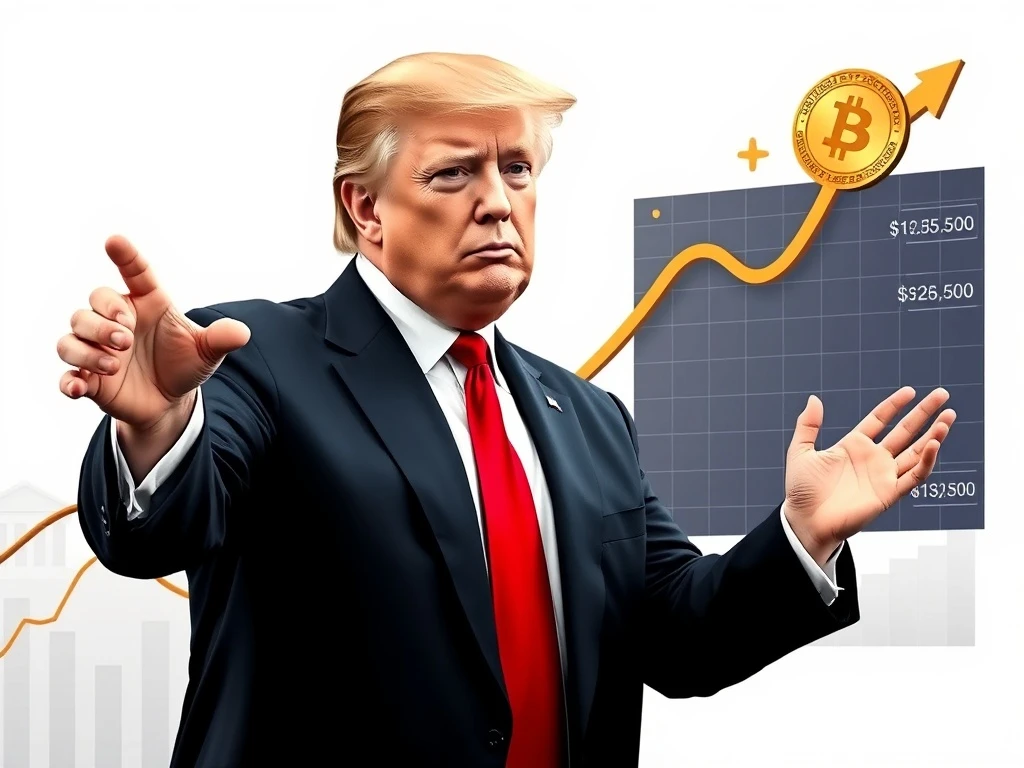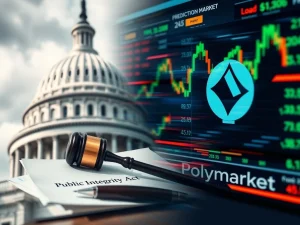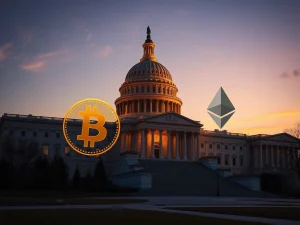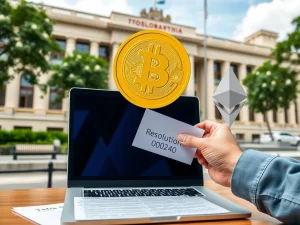Trump Fed Rate Cuts: Unleashing Economic Growth & Cryptocurrency Boom

For anyone keenly observing the intricate dance between global economics and the volatile world of digital assets, former President Donald Trump’s consistent stance on Federal Reserve interest rates holds particular significance. His singular focus on lower rates, confirmed by his former budget director, Mark Vought, wasn’t just about traditional economic levers; it carried profound implications for the burgeoning cryptocurrency market. Understanding the historical context of Trump Fed Rate Cuts offers a crucial lens through which to view potential future market dynamics and the broader economic landscape.
Trump Fed Rate Cuts: A Historical Imperative?
During his time in office, Donald Trump’s message to the Federal Reserve was clear and unwavering: cut interest rates. Mark Vought, who served as director of the U.S. Office of Management and Budget, recently underscored this directive, revealing that Trump’s sole request to the Fed was precisely this – to lower borrowing costs. The primary aim was to stimulate economic growth and investment, a classic approach to injecting liquidity into the system and encouraging spending. This strategy aligns with a long-held belief that reduced interest rates make it cheaper for businesses to borrow and expand, and for consumers to spend, thereby boosting overall economic activity.
- Lower Borrowing Costs: Makes loans more affordable for businesses and consumers.
- Increased Investment: Encourages companies to invest in expansion and innovation.
- Consumer Spending Boost: Frees up capital for individuals, stimulating demand.
- Economic Growth: The cumulative effect of increased spending and investment.
Understanding the Cryptocurrency Market Impact
How do seemingly traditional monetary policies like interest rate cuts resonate within the cutting-edge realm of digital assets? The connection is more direct than many might assume. When interest rates are low, the returns on safer, traditional investments (like bonds or savings accounts) tend to diminish. This environment often pushes investors to seek higher returns in riskier assets. This is where the Cryptocurrency Market Impact becomes evident. Digital assets, known for their volatility and potential for significant gains, become more attractive in a low-interest-rate environment, as investors are more willing to take on risk in pursuit of greater yield. The increased liquidity from rate cuts can also find its way into crypto markets, fueling demand and potentially driving up prices.
However, it’s a double-edged sword. While lower rates can provide a short-term boost, the long-term stability of crypto markets is also influenced by broader economic factors, including inflation and regulatory clarity. Experts often caution that an overreliance on low rates to drive growth can lead to asset bubbles and increased volatility.
Economic Stimulus: The Ripple Effect
The broader goal of Economic Stimulus through rate cuts is to create a vibrant financial environment. When money is cheaper to borrow, it lubricates the wheels of commerce, leading to increased business activity, job creation, and potentially higher wages. This ripple effect can be felt across various sectors, from manufacturing to technology. For cryptocurrencies, a robust economy can mean more disposable income for investors and a greater willingness to explore new investment avenues. Conversely, economic downturns or periods of high inflation can reduce risk appetite, leading to outflows from more speculative assets like crypto.
The administration’s emphasis on accommodative monetary policy during Trump’s tenure reflected a strategic approach to managing economic uncertainty. By prioritizing rate reductions, the team aimed to sustain growth momentum, even while acknowledging underlying inflationary pressures. This strategy aligns with historical patterns where central banks deploy rate cuts to invigorate demand during periods of economic slowdown.
Navigating Interest Rate Policy and Digital Asset Growth
The Federal Reserve’s delicate balancing act between fostering growth and containing inflation is central to any discussion of Interest Rate Policy. While rate cuts can undoubtedly provide a temporary market uplift, they carry the inherent risk of exacerbating inflationary pressures if not meticulously calibrated. Policymakers must constantly weigh the immediate allure of short-term growth incentives against the imperative of long-term economic stability. This careful consideration is particularly vital for sectors highly sensitive to macroeconomic shifts, and the crypto markets are a prime example.
The interplay between interest rates and the trajectory of Digital Asset Growth is complex and multifaceted. While lower rates can reduce the cost of capital, thereby encouraging investment in higher-risk assets, they are not the sole determinant of market performance. Regulatory frameworks, technological advancements, institutional adoption, and evolving investor sentiment all play equally crucial roles. Therefore, while monetary policy certainly influences the tides, it cannot single-handedly dictate the ultimate direction of crypto market trajectories.
The Enduring Debate: Rates, Economy, and Crypto
Donald Trump’s consistent push for lower interest rates underscores a fundamental debate in economic policy: how best to stimulate growth without triggering unwanted inflation. His administration believed that aggressive rate cuts were key to unlocking further economic potential. This perspective, while rooted in traditional economic theory, has significant implications for modern asset classes like cryptocurrencies. The increased liquidity and reduced returns on safer assets that often accompany lower rates can indeed funnel capital into digital assets, driving their appeal and potentially their value.
However, the journey of crypto markets is influenced by a confluence of factors beyond just interest rates. Regulatory clarity, technological innovation, and broader market sentiment also play pivotal roles. While a low-interest-rate environment might act as a tailwind, it’s the evolving ecosystem of decentralized finance, blockchain utility, and mainstream adoption that truly shapes the long-term future of digital assets. The ongoing dialogue between monetary policy and the crypto world will undoubtedly continue to be a fascinating space to watch.
Frequently Asked Questions (FAQs)
Q1: Why did Donald Trump consistently advocate for Federal Reserve interest rate cuts?
A1: Donald Trump’s primary reason for advocating for rate cuts was to stimulate economic growth and investment. He believed that lower borrowing costs would encourage businesses to expand and consumers to spend, thereby boosting overall economic activity and job creation.
Q2: How do Federal Reserve interest rate cuts typically affect cryptocurrency markets?
A2: Interest rate cuts generally increase liquidity in the financial system and reduce returns on safer investments. This often encourages investors to seek higher returns in riskier assets, including cryptocurrencies, making digital assets more attractive and potentially leading to increased investment and price appreciation.
Q3: What are the potential risks associated with aggressive interest rate cuts?
A3: While rate cuts can stimulate growth, aggressive cuts carry the risk of exacerbating inflation if not carefully managed. They can also lead to asset bubbles, where asset prices become overinflated, and increase market volatility, especially in speculative sectors like crypto.
Q4: Is monetary policy the only factor influencing digital asset growth?
A4: No, monetary policy, while influential, is not the sole factor. Digital asset growth is also significantly impacted by regulatory developments, technological advancements (e.g., blockchain innovation), institutional adoption, overall market sentiment, and the utility of specific cryptocurrencies within their ecosystems.
Q5: What role does liquidity play in the relationship between interest rates and crypto?
A5: Lower interest rates typically lead to increased liquidity in the financial system. This means more capital is available for investment. A portion of this increased liquidity often flows into higher-risk, higher-reward assets like cryptocurrencies, as investors look for better returns than what traditional low-yield investments offer.









